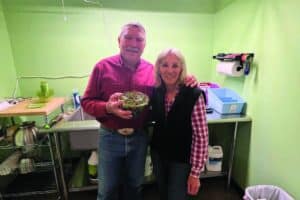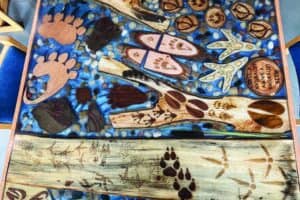Colorado will never have the lush, rolling green landscapes of the Appalachians. Colorado, for that matter, will never have the abundant water supply of many states in the nation. Like it or not, this is a semi-arid environment.The natural beauty of Colorado, however, is undoubtedly of a majestic variety. As more people continue to move to Colorado Springs and as more land is being developed, many folks are looking for alternatives to traditional, and typical, landscape designs.”When I grew up here in Colorado, we had the big Kentucky bluegrass lawn with maybe a few trees, and that was what we called landscaping,” said Chuck Montera of Sigler Communications. In Colorado, about 80 to 90 percent of all water goes for agricultural use, said Linda Firth, community relations manager of Denver Water. “Mostly it is for growing crops for livestock,” she said. A significant amount, she said, is also used for popular crops like Rocky Ford melons. Only about 10 percent of all the water in Colorado goes toward use in municipalities, Firth said, and 70 percent of summer water use in Colorado municipalities if used for landscape watering.People will always want attractive properties, just as they will always use water to care for those properties. There are ways, though, to do more with less. Xeriscape is nothing new. The idea of planting water efficient plants, grasses and shrubs and building walkways and other “hardscapes” really took hold in the early 1980s. With the onset of the drought a few years ago, many businesses and private residences had to cut back on the watering of their lawns. As a result, many lawns turned various shades of brown and yellow. With xeriscape, unsightly brown patches can be avoided. “And it’s the right thing to do,” Firth said. “We live in a high desert.”Xeriscape is not a limiting option by any means, said Kristen Sirovatka, executive director of the Associated Landscape Contractors of Colorado. “Xeriscape is not one particular look. That is one common misconception – it’s not all cactuses,” she said. To create a xeriscape landscape, Sirovatka recommends formulating a plan for proper irrigation, putting turf in places that don’t receive a lot of foot traffic and using mulches to help retain ground moisture.And Kentucky bluegrass is not entirely out of the question when applying xeric principles to a landscape design. “In fact, Kentucky bluegrass can be used well in xeriscape as long as you amend the soil with the proper organic material and you’re watering it correctly,” Sirovatka said.Certain plants have proven popular in xeriscape designs. “Plants are an excellent erosion control item,” Sirovatka said. Popular water-efficient plants include Russian sage, certain species of columbines, ornamental grasses, buffalo grasses, junipers, wooly thyme, mugo pine and the Echinacea plant, which bears purple cone-like flowers. “Cactus is just one of many choices,” she said.While buffalo grasses are more water efficient, they do not take to traffic as well as bluegrass. “If you have animals or kids, you may want to go with bluegrass,” Sirovatka said. “Turf in general does help with cooling. There are some statistics that a certain amount of turf can equal a certain amount of air conditioning for a building.”Sirovatka has seen increased interest in xeriscape through the years. “A lot of our contractors do xeriscape design all the time,” she said. The Associated Landscape Contractors of Colorado was incorporated in 1961 and gave out its first landscape awards in 1979. There were 86 entries for the 2005 awards, including six entries for xeriscape design. Three entrants were grand winners and two were presented with awards of excellence. Many entries in various other categories also incorporated xeric principles, Sirovatka said.One such entry was a renovation project in Colorado Springs completed by Cascade-based Sundown Landscaping and Irrigation. Sundown won a grand award in the renovation category for work completed at the home of Buck Blessing, CEO of Griffis Blessing. “We actually did work throughout the entire yard on all four sides of the house,” Blessing said. His home is a Victorian-style house dating back to 1895 in a historic district of Colorado Springs. “That whole area in the back there was not an attractive space at all,” he said. “It was pretty awful. It was just dirt and weeds.”The scene at Blessing’s home is different today. What exists now is an English-style garden complete with stone walkways (hardscapes), a fountain, a statue and an assortment of shrubs, grasses and plants. Bob Meldon, owner of Sundown Landscaping and Irrigation, added upright junipers to the landscape. “They’re almost like a tree,” he said. “They’re just very water-efficient.” Wooly thyme was planted between the flagstones and some of the grass was kept for groundcover. “There was some existing Kentucky bluegrass in good condition, so we saved that,” Meldon said. “In the main area we replaced all the grass with hard surfaces.”Landscape architect Fawn Bell drew up the plans for the renovation project. “I think Buck probably found out about Fawn Bell somehow,” Meldon said. “She is one of the best landscape architects in Colorado Springs.” Blessing worked with Bell to create the award-winning plans. “The basic design was hers and I sort of tweaked it and I approved it before it went in,” Blessing said.And while his property includes xeric elements, “I don’t think of my garden as being a xeriscape,” he said. Blessing said he is pleased with the results of the renovation. “It takes a lot of maintenance, but it’s beautiful and it’s created some really nice areas to hang out. It’s just a very nice place to relax with friends and a glass of nice wine and it’s just a real peaceful setting.” The renovation project at Blessing’s home was the only project to receive an award in Colorado Springs.Meldon and the Sundown staff also installed a drip irrigation system at Blessing’s property. With the system, areas in the shade are watered less than areas that receive more sunlight. “There were two zones on the drip,” Meldon said.”There’s a science that goes along with irrigation,” Sirovatka said. Sirovatka, Firth and Meldon all said more people are looking to incorporate xeric elements into their private residences and businesses. “Businesses, particularly in the Denver area, are doing a wonderful job of incorporating xeric concepts,” Firth said. “The big answer is that it saves money,” she said. “Let me rephrase that – it saves water.”Sprinklers cannot be left to run freely at everyone’s discretion. “Since the drought started, and that was probably 2001 or so and basically after that happened they put in water restrictions,” Meldon said. “What happened was the lawns couldn’t survive on two days of watering. You can keep sod alive on asphalt if you water it every day.””We should never have been watering like crazy in the first place,” Sirovatka said. “The emergency of it (the drought) may be over, but Colorado will always have to grapple with water issues.”For more information on the Colorado Springs Business Journal, visit www.csbj.com.






